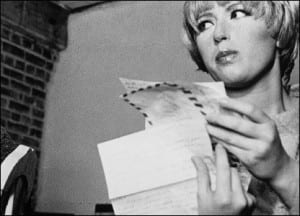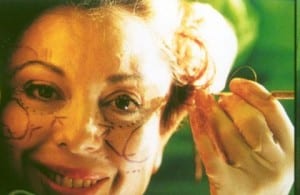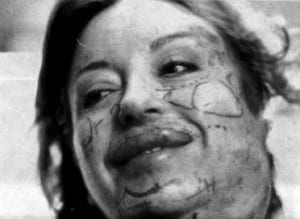According to Glen Ward, Postmodernism ‘is most fruitfully viewed as a variety of perspectives on our contemporary situation.’ (1997, p.4). One of these perspectives that is explored in contemporary performance, is this cultural loss of identity. One of the main influneces on the piece, for me, was two paragraph’s from an essay I wrote in Febuary 2012;
‘Another common notion of postmodernism that is explored in contemporary performance is a cultural loss of identity. As Glen Ward states ‘There are many sides to the unfolding story of postmodern identity, but if there is one central theme, it is that the self is fundamentally social’ (1997 p.105). He agrees with Baudillard’s theory that, ‘we can experience the world only through a kind of filter of preconceptions and expectations fabricated in advance by a culture swapped by images’ (Ward 1997, p.60). It is these images that affect the metropolis with all these contrasting notions of identity becoming distorted and fragmented through the infiltration of the mass media into the fabric of our society, ‘in place of the serious modernist search for the deep authentic self’ (Ward 1997, p.108). Photographer Cindy Sherman, ‘self – consciously enacts the repetitions through which, identity is produced and changed demonstrating identity’s performativity’ (Allain and Harvie 2006, p.135), in her 1977-1980 work ‘Untitled film stills’. Her staged images of female stereotypes from film and television ‘shows that culture provides a multitude of images and that the ability to combine these into new configurations creates a ‘play of signs’ in which you can construct an empowering sense of individuality’ (Ward 1997, p.123). But with women being able to carry a multitude of identities with them through the postmodern culture, ‘did the very multiplicity of images suggest that herself was a multiple of fragmented’ (Ward 1997, p.121). Her work in effect explores the postmodernist ideal of performance in everyday life, that ‘people are not simply being, they are performing, both consciously and subconsciously’ (Allain and Harvie 2006, p.151).


The Performance artist Orlan, takes the ideas of Sherman’s work, but takes it a step further as ‘she alters her own body and uses multimedia technology to explore and create new mediated and performative definitions of identity’ (Allain and Harvie 2006, p.59). In her 1990-1993 key piece Reincarnation of Saint Orlan, she staged herself on a live feed in galleries and online, having plastic surgery to ‘alter her face to incorporate features from famous works of art … Orlan was not trying to make herself a static image of ideal beauty’ (Allain and Harvie 2006, p.111). Instead, with Orlan’s ‘use of cosmetic surgery as a medium for artistic expression, she amplifies the social pressures on women to conform to a narrowly defined, patriarchal standards of beauty … her work exposes the violence of these beauty standards’ (Faber 2007, p.118). The postmodernist aesthetic of using body art to challenge the fragmentation and manipulation of identity in our society, allows ‘her art to dissolve distinctions between subject and object, author and work, in and through her transformations of her own body as a work of art within a framework’ (Faber 2007, p.120). With the fragmentation of her work and how it is documented, defuses this notion of “high” and “low” art in a postmodernist culture, effectively destroying the Modernists’ secularisations of what art is. This can be seen with Orlan’s work, by making it available on the internet, and letting people speak to her via a newsfeed whilst she is performing. This has been able to be achieved as the internet has become a more contemporary postmodernist performance platform to reach the masses, which allows artists to continually exchange and create an open – ended performance and dialogue with their audience’ (Britten 2012, p6-7).


These paragraphs really helped to inform our performance in a more theoretical concept, especially shaping our ‘characters’ or ‘alias’ to adopt in performance. We decided to follow through on the influence and dominance of Social Media which means that in our Postmodern society, our virtual prescence is more important than our real prescence.This is reflected in the characters we portrayed being exaggerated stereotypical personalities, with a Geisha, English Eccentric, L.A. Detective from the 50’s, and a French Maid. We wanted to show how the internet can be a dangerous place for the postmodern indivdiual, due to the society becoming more fragmented through the loss of our identities, we have become disillusioned to ourselves, aswell as a society that surrounds us.
In today’s society, especially in our generation, if you aren’t on Facebook, Twitter, TumblR, MySpace, etc, or don’t have some sort of virtual presence, then it is like you do not exist. No-one will remember your birthday, you won’t be invited out, you will be socially excluded.’
By Rebecca Britten.
Works Cited
Allain, Paul and Jen Harvie (2006) The Routledge Companion to Theatre and Performance, London and New York: Routledge.
Britten, Rebecca (2012)‘Consider and discuss the relationship between contemporary performance and the notion of postmodernism. Include in your discussion detailed reference to at least two of the practioners studied on the course, and at least two of the key theorists.’ Lincoln School of Performing Arts: Lincoln.
Faber, Alyda (2007) ‘Saint Orlan: Ritual as Violent Spectacle and Cultural Criticism’ in Henry Bial’s (ed.) The Performance Studies Reader, London and New York: Routledge.
Ward, Glen (1997) Teach Yourself Postmodernism?, London: Hodder and Stoughton.